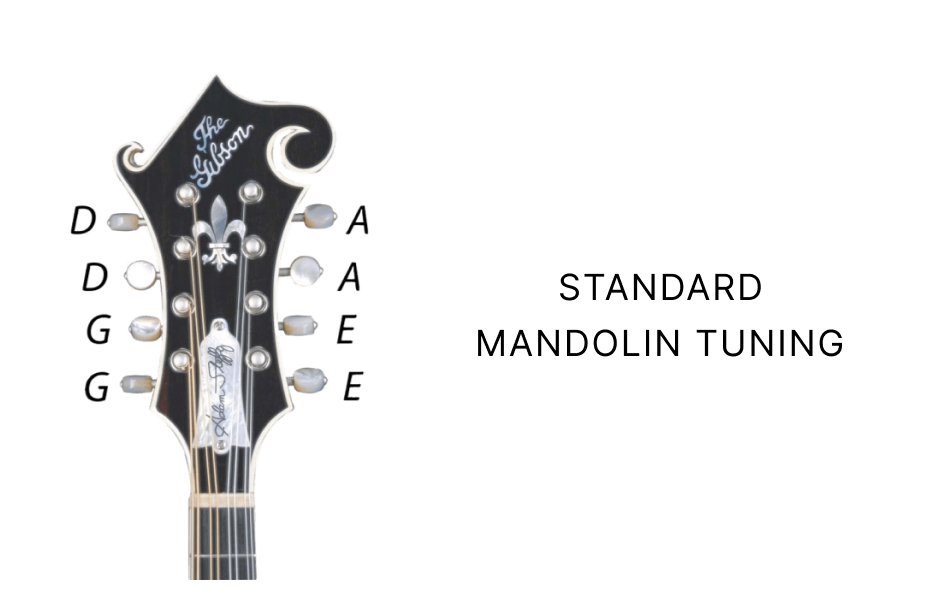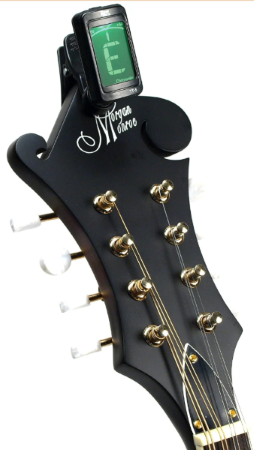The mandolin is an incredible instrument with a crisp, clear, romantic, and classical sound. However, this beautiful sound will be completely distorted once the instrument is out of tune. Therefore, make sure that your mandolin is always correctly tuned before playing. In this article, we will show you all you need to know to tune a mandolin.
Contents
Standard mandolin tuning (G D A E)

Tuning for mandolins is the same as violins, G-D-A-E from low to high, with each pair of strings tuned to the same tone. When you’re holding the mandolin correctly, the thinnest string pair (E) with the highest tone should be the closest to the floor, and the thickest ones (G – lowest tone) are closer to your chest.
- Fourth string pair: G, G
- Third string pair: D, D
- Second string pair: A, A
- First string pair: E, E
How to tune a mandolin
There are many ways to tune a mandolin. We’ll start with the easiest.
How to tune a mandolin with Guitar Tunio
Tuning by a mobile mandolin tuner app is the easiest, fastest, and most convenient way. Guitar Tunio is the reliable tuning app you’ve been looking for. In this app, you can find a smart mandolin tuner that helps you effortlessly and accurately tune your instrument. The tuner has two tuning modes: Auto and Manual. With Manual mode, you can select the string you’d like to tune on the screen and the app will play the exact tone of that string for you to tune. The Auto mode is even easier. You just play any mandolin string, the app will automatically determine what string you are trying to tune and then guide you to tune it correctly. Too simple, right? So download Guitar Tunio Pro now to get your instrument tuned. It’s available on the App Store and Google Play, check it out!

After installing Guitar Tunio successfully, open it and follow these steps to tune the mandolin.
- Step 1: In the settings select Tuning Mode, drag right to find Folk Instrument, and then select a tuning for the mandolin you want to start.
- Step 2: Identify the string you want to tune
- Step 3: Turn the tuning peg of that string on the mandolin to adjust the tension and watch the app’s indicator move to tune correctly.
Once the indicator reaches the middle of the screen, your string is in tune, and you can move on to the next.
You can click here to see more about our best mandolin tuner app.
Use an electronic tuner
Using a digital or clip-on electric tuner is one of the most accurate and efficient ways to tune your mandolin. If selecting this method, get yourself a good quality electric tuner and be sure that it works with the mandolin. And, for best results, you should find a quiet space to tune in.

To tune with an electronic tuner, you do the following:
- Step 1: Clip the electronic tuner to your mandolin headstock
- Step 2: Play and tune each string individually.
- Step 3: Turn the tuning peg to adjust the tension, and watch the tuner closely for cues. The tuner gives you an indication of whether or not you’re sharp or flat, and turn green or blink when you’re right in tune.
- Step 4: Go back through the strings again and play each double set to make sure it sounds right. Listen closely to the doubled strings to see if it needs further adjustment.
Tune with a tuning fork
The third method we’d like to introduce is to tune with a tuning fork. You use the fork as a reference for the pitch of the string.

To actually use the tuning fork, you simply hit it against a hard object to get it to generate a tone. For the mandolin, the tuning fork that produces an “E” is most useful, and you can use it to tune your E string. The strings are all related. So once the E string is well-tuned, you can rely on it to tune all the remaining strings.
Tune a mandolin to itself
Another way, more popular with experienced players, is to tune a mandolin to itself. This means using one string as a reference point to tune another. You may not always have a tuner on hand, so it’s an important skill to learn.

This is also the way that you use a tuning fork or one reference pitch to tune the whole instrument. Once you’ve tuned the E string, you can use it to generate a tone for the other strings. If you tune the E and then play the string above (A) at the 7th fret, it should sound the same. If it doesn’t, adjust the A string until it is in tune. Repeat this along the mandolin.
How to tune a mandolin to another instrument
The G-D-A-E strings are on other instruments, so you can use them as a reference for tuning. Use an in-tune piano or guitar to tune your mandolin up. Play the note on the piano (or play a guitar string) and adjust the corresponding string on your mandolin until the pitch is the same.
Alternate tunings
In addition to the standard tuning, you can try other alternate tunings. Different tunings will give you different sound experiences. Try out:
- Sawmill tuning (GDGD)
- Open G (GDGB)
- Irish tuning (GDAD)
It’s fun to experiment with different tunings.
Above is everything you should know about mandolin tuning. Now choose a suitable method and start tuning your mandolin.
